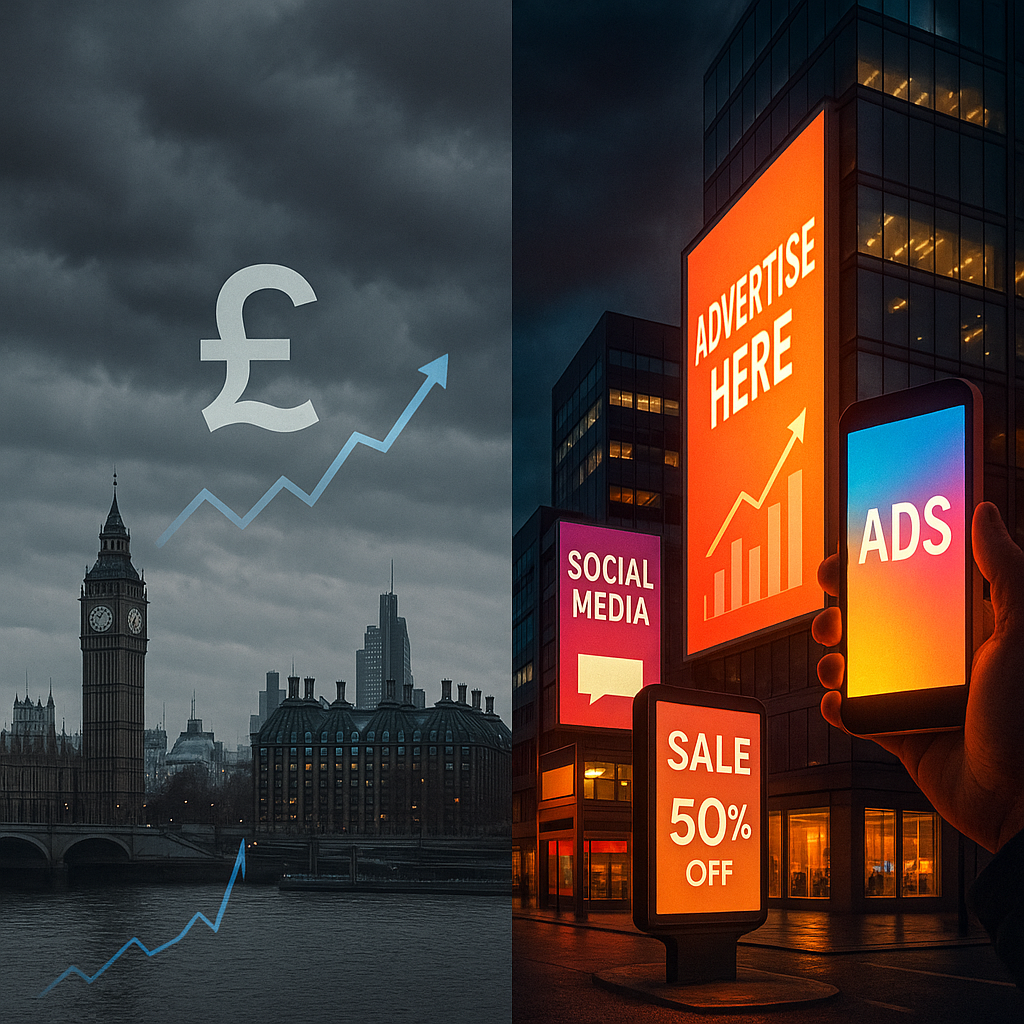If you’d looked at the UK economy in 2024 — slow growth, rising business costs, general sense of “meh” — and guessed advertising would have a quiet year, you wouldn’t have been alone. But you’d have been wrong.
Instead, the UK ad market hit a record £42.6 billion, growing 7.6% in real terms (10% nominal). That’s not just healthy. That’s headline-grabbing — especially when the wider economy grew just 1.1%.
It raises the obvious question: why?
And the less obvious one: what does this say about the mindset of modern businesses — or people in general?
Let’s unpack that. Not in a tidy way, but in a way that feels more like thinking through it out loud.
A Market That’s Anxious — But Active
At first glance, the numbers look like a vote of confidence. But if you dig into the forecasts and the tone of the commentary, it’s clear that optimism isn’t really what’s driving this.
It’s control.
There’s something very human — and very business-y — about clinging to the few things you can influence when the rest of the world feels wobbly. Supply chains are fragile. Inflation is unpredictable. Trade tariffs from the US could be just a warm-up. And many businesses are still dealing with fresh tax changes here at home.
So, rather than freeze, they push forward. Maybe not because they feel bold, but because they know what happens when they don’t. That’s a very different kind of confidence — more calculated, maybe even a bit desperate in places. But it gets results.
The Pull of the Short-Term (and the Long Game We Pretend We’re Playing)
Here’s the tension: when money’s tight, cutting ad budgets often feels sensible. A clean cost-saving. No immediate pain. It’s easy to justify — especially to yourself.
But the data says the opposite. Brands that stay visible during downturns don’t just survive; they tend to come out stronger. It’s not new wisdom. It just feels harder to follow when your accountant’s suggesting otherwise.
James McDonald from WARC phrased it a little more formally, noting that short-termism is a threat to brand equity. Fair enough. But the underlying idea is this: going quiet now might keep the lights on this quarter — but it dims your long-term signal. And rebuilding that later costs more. In money, time, and trust.
So yes, companies are still spending. Maybe nervously, maybe not always consistently. But they’re spending — because fading out of sight feels riskier.
Where’s the Money Going?
This is the part that, at least to me, really reveals something about modern consumer psychology. Or maybe media psychology? Probably both.
According to the report:
- Online advertising now takes £4 of every £5 spent.
- Search is up nearly 13%, to £16.9bn.
- Online display jumped over 15%, and half of that was on social platforms.
- Retail media — ads inside shopping ecosystems — rose 22.7%.
- And interestingly, cinema was up over 24%, showing we haven’t all given up on the outside world.
It’s easy to say this just reflects where people spend their time. But it’s more than that.
It shows that advertisers want precision. They want moments where people are already leaning in — already looking, shopping, scrolling, maybe even pausing between things. They want to appear not just at the right time, but in the right mood.
There’s a subtle psychological game in play. It’s less about shouting for attention, more about quietly sliding into your decision-making window and making sure you don’t scroll past.
The Myth of “Generic Reach”
Once upon a time, TV was king. It still holds value — especially in VOD formats, which grew by more than 23% in Q4. But even TV is shifting. It’s not mass marketing anymore. It’s segmented. Layered. Interactive, sometimes.
And then there’s retail media. A strange category on the surface, but when you think about it, it makes sense. People are already in a “yes” mindset. They’re literally browsing, comparing, checking out. And the ad — which might feel intrusive in another context — feels more like a suggestion here.
Same with search. People don’t want to be interrupted. They want to be helped. It’s not a trick. It’s just timing.
Maybe that’s the through-line here: the most effective ads are the ones that don’t feel like ads.
But Still… Fragile Confidence Lurks
Despite all the upward momentum, there’s an undertone in the report that’s hard to ignore. Even as spending rises, business confidence feels… brittle. Like if one or two things go wrong — a surprise rate hike, a sharp drop in consumer spending — the whole thing could wobble.
Forecasts for 2025 and 2026 show continued growth (6.3% and 5.6% respectively), but the tone has shifted slightly since January. There’s talk of “geopolitical headwinds,” which is a polite way of saying nobody knows what’s next.
And that uncertainty bleeds into decisions. Some companies will pull back too soon. Others might overextend. The psychology of it all is messy.
But even with that risk, most are still betting on visibility. Because, ironically, invisibility feels even riskier.
A Quiet Point to End On
Here’s the thought I keep coming back to: advertising spend isn’t just a reflection of strategy. It’s a reflection of belief. Or fear. Or both.
You don’t pour money into ads if you don’t believe someone’s watching. Or might be. Or will be soon.
So yes, the £42.6bn figure is impressive. But what it really shows is that — deep down — businesses still think there’s something worth fighting for. Customers still looking. Loyalty still winnable. Demand, even if it’s dormant, still out there.
That doesn’t mean we’re all feeling bullish. Just… alert.
And maybe that’s enough.



